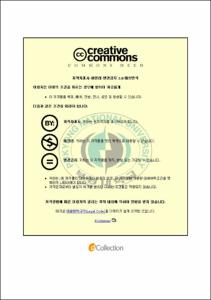해양미생물로 부터 subtilisin-like proteinase inhibitor를 생산하는 균주동정 및 정제특성
- Alternative Title
- Identification and Purification Properties of Subtilisin-like Proteinase Inhibitor Isolated from the Marine Bacterium
- Abstract
- A marine bacteria which produced the subtilisin-like proteinase inhibitor was screened from the sediment in the southern sea of Korea. The cultureal, morphological and physiological characteristics of an isolated strain were investigated for identification. Cultural characteristics based on ISP(International Streptomyces Project) were as follows: white and gray aerial mycelium and good growth on various medium. Also, the strain did not produce the soluble pigment. Also, this strain could be grown up to 9% salt concentration. Morphological and physiological characteristics showed cylindrical spore chain and smooth spore surface by SEM(Scanning Electron Microscope). A phylogenetic analysis of the 16S rDNA provided a clue that the isolated strain was actually a member of the genus Streptomyces, because the determined sequence exhibited a higher homology with Streptomyces thermocarboxydus.
A subtilisin-like proteinase inhibitor has effectively inhibited the activity of subtilisin and proteinase K by complexing with the enzyme in the ratio of 1 : 1. The inhibitor has no effect on the trypsin and collagenase. The optimum culture conditions for the production of subtilisin-like proteinase inhibitor have been determined after cultivation for 3 days at 28℃. Glucose, galactose, starch and fructose were good carbon sources for the production of the inhibitors. On the other hand, maltose, lactose and mannose was only good for the cell growth potently inhibited the production of inhibitor. Natural organic nitrogen sources such as poly peptone and proteose peptone were good for the production of inhibitor, however beef extract, urea, casamino acid and inorganic nitrogen sources such as (NH4)2SO4 and NH4Cl were poor. Optimal culture conditions for inhibitor production were composed of 1.6% galactose, 0.5% proteose peptone, 1% NaCl and 1 mM Li+, respectively. The optimal temperature and initial pH for the subtilisin-like proteinase inhibitor activity were 40℃ and pH8.0, respectively. The subtilisin-like protease inhibitor from Streptomyces thermocarboxydus C12 showed a maximum inhibitor activity after the cultivation for 60 h under the optimized medium.
A subtilisin-like proteinase inhibitor produced by Streptomyces thermocarboxydus C12 was purified by ultrafiltration, ammonium sulfate precipitation, DEAE Sepharose CL-6B and Superdex 200 column chromatography. The final inhibitor was purified 119.9 fold, with a yield of 20.7%. The inhibitor has a monomer with a molecular weight of 33.1 kDa estimated by SDS-PAGE. Also, the inhibitor showed the one band in native-gel PAGE. The isoelectric point was 4.4. The inhibitor activity was stable in the range of pH 6.0~10.0 and temperature 30-60℃, respectively. The purified inhibitor was slowly activated by Mg2+ and K+. The N-terminal sequence of subtilisin-like proteinase inhibitor was determined as DAPSALYAPSALVL TVGKGVSAT. The sequence (residues from 1 to 23) was 100% identified with the Streptomyces subtilisin inhibitor(SSI) produced in the Streptomyces albogriseolus. The Km and Vmax of the inhibitor were calculated to be 2.67 mg and 15.3 unit, respectively. The inhibitor showed a noncompetitive inhibitor mode for subtilisin. As a result of a amino acid compositon analysis, the purified inhibitor had a high content of serine and alanine. The degree of inhibition of subtilisin-like proteinase inhibitor was much greater than that of food inhibitor such as bovine plasma, pork plasma and egg white protein.
- Issued Date
- 2007
- Awarded Date
- 2007. 2
- Type
- Dissertation
- Publisher
- 부경대학교 대학원
- Alternative Author(s)
- Kang, Sung-Il
- Affiliation
- 부경대학교 대학원
- Department
- 대학원 생물공학과
- Advisor
- 공재열
- Table Of Contents
- 제 1 장 서론 = 1
1. Protease inhibitor = 1
1-1. Protease에 대한 inhibitor 연구 = 1
1-2. Protease의 inhibitor 분류 = 5
2. Protease inhibitor의 응용 = 7
제 2 장 재료 및 방법 = 10
1. 시약 = 10
2. 균주의 분리동정 및 최적배양조건 측정 = 10
2-1. 배지조성 및 배양방법 = 10
2-2. 균주분리 및 보존 = 11
2-3. 분리균주의 동정 = 11
2-4. 16S rDNA 염기서열 분석 = 13
2-5. 종족 계통적 분석 = 14
2-6. 단백질 정량 = 14
2-7. 효소 저해활성 측정 = 14
2-8. 저해제 생산을 위한 최적배양조건 검토 = 16
3. Subtilisin-like proteinase inhibitor의 분리·정제 및 특성 = 18
3-1. Subtilisin-like proteinase inhibitor의 분리·정제 = 18
3-2. Subtilisin-like proteinase inhibitor의 이화학적 특성조사 = 19
1) 분자량 측정 = 19
2) 등전점 측정 = 19
3) 아미노산 조성분석 = 21
4) N-terminal sequence 분석 = 21
5) 저해제 온도 안정성 = 23
6) 저해제 pH 안정성 = 24
7) 금속이온의 영향 = 24
8) 여러 가지 단백질 분해효소에 대한 저해효과 = 24
9) Subtilisin에 대한 inhibitor의 kinetics = 24
10) 식품급 저해제와 저해율 비교 = 25
제 3 장 결과 및 고찰 = 26
1. 균주의 분리 및 동정 = 26
2. 저해제 생산을 위한 최적배양조건 검토 = 27
2-1. 배양온도의 영향 = 27
2-2. 초기 pH의 영향 = 41
2-3. 탄소원의 영향 = 41
2-4. 질소원의 영향 = 44
2-5. NaCl 농도의 영향 = 47
2-6. Metal salts의 첨가 효과 = 47
2-7. 최적배양조건에서 저해제의 생산 = 51
3. Subtilisin-like proteinase inhibitor의 분리·정제 = 54
3-1. Subtilisin-like proteinase inhibitor의 분리·정제 = 54
3-2. 분자량 측정 = 61
4. Subtilisin-like proteinase inhibitor의 이화학적 특성 = 61
4-1. 저해제의 온도 및 pH 안정성 = 61
4-2. 저해제의 등전점 = 65
4-3. 금속이온의 영향 = 65
4-4. 여러 가지 단백질 분해효소에 대한 저해효과 = 68
4-5. Subtilisin에 대한 inhibitor의 kinetics = 68
4-6. 아미노산 조성분석 = 68
4-7. N-terminal sequence 분석 = 71
4-8. 식품급 저해제와 저해율 비교 = 75
제 4 장 결론 = 77
참고 문헌 = 82
- Degree
- Doctor
- Files in This Item:
-
-
Download
 해양미생물로 부터 subtilisin-like proteinase inhibitor를 생산하는 균주동정 및 정제특성.pdf
기타 데이터 / 1.2 MB / Adobe PDF
해양미생물로 부터 subtilisin-like proteinase inhibitor를 생산하는 균주동정 및 정제특성.pdf
기타 데이터 / 1.2 MB / Adobe PDF
-
Items in Repository are protected by copyright, with all rights reserved, unless otherwise indicated.